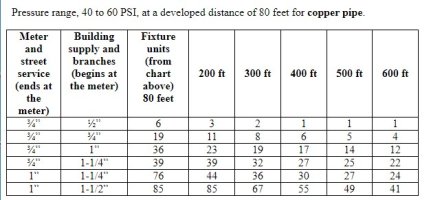A_Numbie1
New Member
Hi - I'm putting in new city water service (tired of the well). My home is ~400 feet from the 16" main with 60-65psi. Originally, I was thinking of going with a 1" tap & meter hooked to a 1 1/2" line to the house. I only have 27 fixture units. Only 2 adults live in the house and there is very little elevation change (ranch house on flat land). I talked with a neighbor who has a similar distance and he has only a 5/8" meter connected to a 1 1/2" line and says he has no pressure issues. I have found Terry's chart on sizing & distance (below) but he didn't list 3/4 meter with 1 1/2" line. The highest the chart went in pipe size with a 3/4" meter was 1 1/4 line. My only choices are 1"line or 1 1/2" line here locally. Will a 1 1/2 line be okay with a 3/4 meter/tap or should I use 1" pipe with my 3/4' meter instead?

